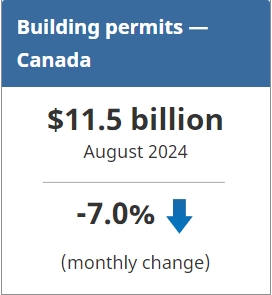Statistics Canada: Building Permits, August 2024

The total value of building permits in Canada decreased by $858.1 million (-7.0%) to $11.5 billion in August, following a strong July during which construction intentions rose sharply (+20.8%). The residential and non-residential sectors contributed to the decrease in August.
On a constant dollar basis (2017=100), the total value of building permits decreased 7.6% in August.
The non-residential sector declines in all three components despite sustained industrial permit level
The value of non-residential building permits decreased by $471.0 million (-9.7%) to $4.4 billion in August, driven by declines in institutional (-$382.2 million) construction intentions. Both the commercial (-$46.2 million) and industrial (-$42.6 million) components also contributed to the decline in the non-residential sector.
The industrial component’s monthly decline in August followed strong growth in July. Despite the monthly decline in August, the industrial component was the fourth-highest value in the series and experienced a year-over-year growth of 49.0%, a second consecutive year-over-year increase. The industrial component’s relatively high level was driven by battery plant permits that were valued at over $900 million in St. Thomas, Ontario. The permits follow a series of construction intentions to build up the battery supply chain in municipalities including Windsor, Ontario, and Bécancour, Quebec. Construction plans for battery manufacturing are a part of the federal government’s and the Ontario and Quebec provincial government’s efforts to develop Canada’s electric vehicle supply chain.
Reductions in multi-unit construction intentions slow down the residential sector
Residential building permits fell by $387.2 million (-5.2%) to $7.1 billion in August, driven by the multi-unit component (-$538.2 million), while the single-family component (+$151.0 million) tempered the decline. Ontario (-$308.3 million) and British Columbia (-$127.4 million) led the declines in multi-unit permit values. For the single-family component, Alberta (+$102.8 million) and Ontario (+$75.3 million) were the major contributors to the growth recorded in August.
Across Canada, 18,500 new multi-family dwellings and 4,700 new single-family dwellings were authorized in August, representing a 4.1% decrease in the total number of units approved through permit issuance. Despite a decrease in the total number of units authorized in the month, the 12-month cumulative total of units authorized from September 2023 to August 2024 grew 2.8% to 268,200, compared with 260,900 having been units authorized from September 2022 to August 2023.
To explore data using an interactive user interface, visit the Building permits: Interactive Dashboard.
For more information on construction, please visit the Construction statistics portal.
For more information on housing, please visit the Housing statistics portal.
Note to readers
Unless otherwise stated, this release presents seasonally adjusted data with current dollar values, which facilitate month-to-month and quarter-to-quarter comparisons by removing the effects of seasonal variations. For information on seasonal adjustment, see Seasonally adjusted data – Frequently asked questions.
For information on trend-cycle data, see the page Trend-cycle estimates – Frequently asked questions.
Building components
- Single-family dwellings: Residential buildings containing only one dwelling unit (e.g., single-detached house, bungalow, linked home [linked at the foundation]).
- Multi-family dwellings: Residential buildings containing multiple dwelling units (e.g., apartment, apartment condominium, row house, semi-detached house).
- Industrial buildings: Buildings used in the processing or production of goods or related to transportation and communication.
- Commercial buildings: Buildings used in the trade or distribution of goods and services, including office buildings.
- Institutional and government buildings: Buildings used to house public and semi-public services, such as those related to health and welfare, education or public administration, and buildings used for religious services.
Revision
Data are subject to revisions based on late responses, methodological changes and classification updates. Unadjusted data have been revised for the previous month. Seasonally adjusted data have been revised for the previous three months.
Next release
Data on building permits for September will be released on November 12.
Source: Statistics Canada


